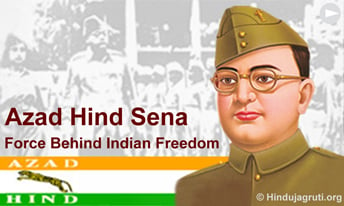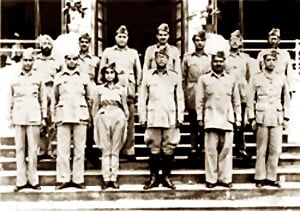Azad Hind Fauj : Force behind Indian Freedom
 |
Index
- Aim
- Idea behind the Army
- The First INA
- Rise of the Second INA
- Provisional Government of Azad Hind Fauj
- Impact on British regime in India
Aim
After his dramatic escape from Calcutta in 1941, Subhas Chandra Bose reached Tokyo from Germany in the first week of June 1943 and from there he went to Singapore. In a historic public meeting held in Singapore on 4th July 1943, Rash Behari Bose handed over the reigns of the Indian Independence League to him. After assuming command as president of the League, Subhas Chandra Bose came to be known as 'Netaji'.
The formation of the Azad Hind Fauj (Indian National Army) was formally announced on 5th July 1943 when Netaji gave his comrades a war cry of 'Delhi Chalo'.
The aim of the army was to overthrow the British Raj in colonial India, with Japanese assistance. Initially composed of Indian prisoners of war captured by Japan in her Malayan campaign and at Singapore, it later drew large numbers of volunteers from Indian expatriate population in Malaya and Burma.
The formation of the Azad Hind Fauj (Indian National Army) was formally announced on 5th July 1943 when Netaji gave his comrades a war cry of 'Delhi Chalo'.
The aim of the army was to overthrow the British Raj in colonial India, with Japanese assistance. Initially composed of Indian prisoners of war captured by Japan in her Malayan campaign and at Singapore, it later drew large numbers of volunteers from Indian expatriate population in Malaya and Burma.
Idea behind the Army
The idea of armed force fighting its way in India to overthrow British Raj originated during the first world war when the Ghadar Party and the nascent embryo of the Indian Independence League planned to rebel in the British Indian Army from the Punjab through Bengal to Hong Kong. But this plan ultimately failed after the information was leaked to British Intellegence. During the outbreak of war in Europe, Subhash Chandra Bose saw an opportunity to authorize on Britain`s weakness. In January 1941, Bose went to Russia from Calcutta via Afghanistan. He tried to secure support for an armed insurrection in India. Instead of paying attention on Bose had to say Russia sent him to Berlin where he started having discussions with the Foreign and Propaganda Ministries. For the next six months, Bose and his assistants led an intensive recruiting campaign amongst Indian POWs (prisoners of war).The plan that had failed during first world war was reopened by the Indian Independence League. It was out in two phases: firstly formation and subsequent disbandment of Indian National Army under Capt. Mohan Singh Deb and secondly formation of Arzi Hukumat-e-Azad Hind under Subhash Chandra Bose and reformation of the INA as its army.
Consequently in January 1942, the propaganda ministry announced formation of the Indian National Army (Jai Hind) in Berlin. At the end of July 1942, three hundred volunteers were issued with German Army Uniforms bearing a badge on right arm showing a leaping tiger superimposed on Indian tricolour, surrounded by the legend "Freies Indien". The men were then officially designated the "Free Indian Legion". In May 1943, the Indian Legion was moved to garrison duties on the Dutch North Sea coast where they were mainly used for the construction of coastal defenses. Following this, they were moved to France. Following the Allied Landings at Normandy, and the rapid advance, the Indian Legion was moved back to Germany in August 1944.
Consequently in January 1942, the propaganda ministry announced formation of the Indian National Army (Jai Hind) in Berlin. At the end of July 1942, three hundred volunteers were issued with German Army Uniforms bearing a badge on right arm showing a leaping tiger superimposed on Indian tricolour, surrounded by the legend "Freies Indien". The men were then officially designated the "Free Indian Legion". In May 1943, the Indian Legion was moved to garrison duties on the Dutch North Sea coast where they were mainly used for the construction of coastal defenses. Following this, they were moved to France. Following the Allied Landings at Normandy, and the rapid advance, the Indian Legion was moved back to Germany in August 1944.
The First INA
In early March 1942, it had been proposed by Japanese advisors that INA become the military arm of IIL, with Rash Behari Bose as the leader. This was announced in June 1942 in Bangkok. In September 1942 the formation of Indian National Army was announced, with Capt. Mohan Singh, 1/14th Regiment, declared the leader. In a public meeting, Singh called upon the Indians to form an army free to India. Almost 20,000 soldiers immediately came forward to join to what was known as Indian National Army. In December, Mohan Singh and other INA leaders ordered the INA to disband after severe disagreements with the Japanese. Mohan Singh was subsequently arrested by Japanese and exiled to Pulau Ubin. Between December 1942 and February 1943, Rash Behari Bose tried but failed to keep the IIL and INA going. Thousands of INA soldiers returned to the status of POWs again and most of the IIL leaders resigned. The movement was seen to be doomed to failure. In a series of meetings between the INA leaders and the Japanese in 1943, it was decided to cede the leadership of the IIL and the INA to Subhash Chandra Bose. Bose had, at the start of the war in Europe, escaped from house arrest to make his way to Germany, reaching Berlin on 2 April 1941. In Germany he convinced Hitler, in a series of conferences, to support the cause of Indian Independence, forming the Free India Legion and the Azad Hind Radio. By early 1943, Bose had turned his attention to Southeast Asia. With its large overseas Indian population, it was recognised that the region was fertile ground for establishing an anti-colonial force to fight the Raj.
Rise of Second INA
In January 1943, the Japanese invited Bose to lead the Indian nationalist movement in East Asia. He accepted and left Germany on 8 February. After a three-month journey by submarine, and a short stop in Singapore, he reached Tokyo on 11 May 1943, where he made a number of radio broadcasts to the Indian communities, exhorting them to join in the fight for India`s Independence. His appeal not only re-energised the fledgling INA, which previously comprised mainly POWs, his appeals also touched a chord with the Indian expatriates in South Asia as local civilians- ranging from barristers to plantation workers - had no military experience joined the INA, doubled its troop strength.
Provisional government of Azad Hind Fauj
 Members of the Government formed by Azad Hind Sena |
After taking over the charge of Indian Independence League from Rash Behari Bose on July 4 he promised the people that he would open second war of independence and set up a Provisonal Government of Free India under whose banner three million Indians of South-East Asia would fight the enemy. On 8 August 1943 Netaji Subhash Chandra Bose assumed office as the Supreme Commander of Azad Hind Fauj. It was founded on October 21, 1943,the government was inspired along the concepts of Netaji Subhash Chandra Bose. The government of Azad Hind had its own currency, court and civil code, and in the eyes of many Indians its existence gave a greater legitimacy to the independence struggle against the British. However, while it possessed all the nominal requisites of a legitimate government, it lacked large and definite areas of sovereign territory until the government assumed control of the Andaman and Nicobar Islands from Japan in 1943 and the occupation of parts of Manipur and Nagaland. Throughout its existence, it remained heavily dependent on Japanese support
Impact
British Prime Minister Clement Atlee cites INA (Indian National Army) activities as one of the influential factor in British decision of leaving India where RIN Mutiny made British realize that it was no longer possible for them to trust the support of the Indian armed forces.
The political effects of the INA trials was enormous and were felt around India as late as 1948, much to the chagrin of the then Indian government.Clement Attlee, the then British Prime Minister, reflecting on the factors that guided the British decision to relinquish the Raj in India, is said to have cited the effects of the INA and Bose's activities on the British Indian Army and the Bombay Mutiny as being the most important.
The political effects of the INA trials was enormous and were felt around India as late as 1948, much to the chagrin of the then Indian government.Clement Attlee, the then British Prime Minister, reflecting on the factors that guided the British decision to relinquish the Raj in India, is said to have cited the effects of the INA and Bose's activities on the British Indian Army and the Bombay Mutiny as being the most important.
Source: 1) Sankalp India 2) Aazad.com





0 comments:
Post a Comment